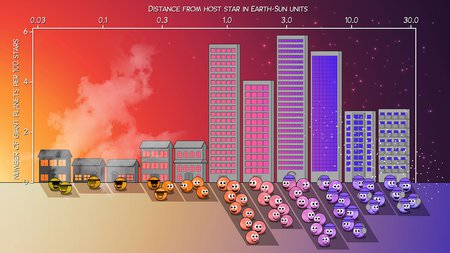One of the unspoken caveats of most exoplanet discovery missions is that they only operate for a few years. Such a short observing window means there are planets with longer orbital periods, usually further out from the star, that those surveys would completely miss. Knowing this would be a problem, a team of astronomers arranged the California Legacy Survey three decades ago in order to monitor as many stars as possible for as long a time as possible. Recently they released their first results, which show solar systems that are surprisingly like our own.
The survey, now led by a team at Caltech, and headed by Dr. Andrew Howard, has been observing 719 sun-like stars as often as possible to catch any potential exoplanet candidates. They found 177 planets in total, including 14 new ones. Ranging in size from 3 to 6000 times the mass of Earth, they push the detection limits for the ground based telescopes at the Keck and Lick observatories that were used as part of the survey. Smaller planets would be impossible to detect with the telescope’s current technology.

Credit: California Legacy Survey / T. Pyle (Caltech / IPAC)
Larger planets were easier to find, and also fit a pattern similar to that of our own solar system. Giant planets, those the size of Jupiter or Saturn, seem to congregate between 1 and 10 AU. These distances fly in the face of many early exoplanet discoveries, where hot Jupiters were popping up consistently in the data. However, those studies were biased to find big planets close to the star, as those conditions would be the easiest to detect using the radial velocity method many early surveys relied upon.
Whether or not larger planets are consistently present beyond 10 AU, as Neptune and Uranus are in our own system, is still difficult to determine. A planet similar to Saturn, which at 9 AU orbits the sun approximately every 29 years, is at the limit of even the current survey’s detection threshold. Anything farther out with a longer orbital period might not even have been detectable in the 30 years of data the survey collected.

Credit: Caltech
Those 30 years are simply a milestone though, as the survey intends to continue collecting data for the foreseeable future. Even better, it is getting a technological upgrade that will allow it to detect smaller planets than ever before. In 2022, the Keck Planet Finder is expected to be installed, which would allow the famous observatory to detect planets down to the size of Earth. Hopefully it won’t take 30 more years for the Caltech team to find some interesting new data points.
Learn More:
Caltech – Giant Planets Found in the Stellar Suburbs
arXiv – The California Legacy Survey I. A Catalog of 177 Planets from Precision Radial Velocity Monitoring of 719 Nearby Stars over Three Decades
arXiv – The California Legacy Survey II. Occurrence of Giant Planets Beyond the Ice line
Keck Observatory – 30-Year Stellar Survey Cracks Mysteries Of Galaxy’s Giant Planets
UCR – Project illuminates where giant exoplanets reside
Lead Image:
Three different telescopes used in the survey. From left to right – the Shane Telescope (Lick), the Automated Planet Finder (Lick), and the W. M. Keck Observatory.
Credit: Laurie Hatch (Lick Observatory) / Rick Peterson (W. M. Keck Observatory)

